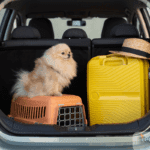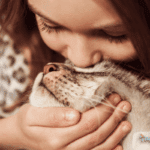Harmony between cat and dog
Picture this: You’ve just brought home a playful puppy, only to watch your cat retreat to the highest perch in the house, glaring down like royalty who’s had their throne invaded. Or perhaps your exuberant dog is barking excitedly at the new feline family member, while the cat hisses and darts for cover. Sound familiar? You’re not alone.
As a small animal veterinarian, I’ve seen countless families navigate the rocky beginnings of a dog-and-cat household. The good news? With the right approach, you can transform these early tensions into a peaceful, harmonious coexistence. It’s not just about making introductions; it’s about building a foundation where both pets feel safe, respected, and even bonded.
This guide is here to help you every step of the way. Drawing on expert insights, proven strategies, and practical tools, we’ll explore how to:
- • Understanding Natural Behaviors: Learn to recognize and work with your pets’ instincts and personalities for better cooperation.
- • Creating a Safe Environment: Set up your home to minimize stress and maximize comfort for both pets.
- • Thoughtful Introductions: Follow our step-by-step approach to gradually introduce your dog and cat.
- • Building Lasting Harmony: Learn strategies to foster long-term peace and address common challenges.
Ready to Begin? By following this guide, you’ll gain the confidence to create a harmonious multi-pet household where tails wag and purrs abound. Let’s get started on your journey to pet harmony!
Recommended Reading:
- 10 Things to Consider Before Bringing a New Pet Home
- Deepening the Bond: 7 Proven Strategies to Strengthen Your Connection with Your Pet
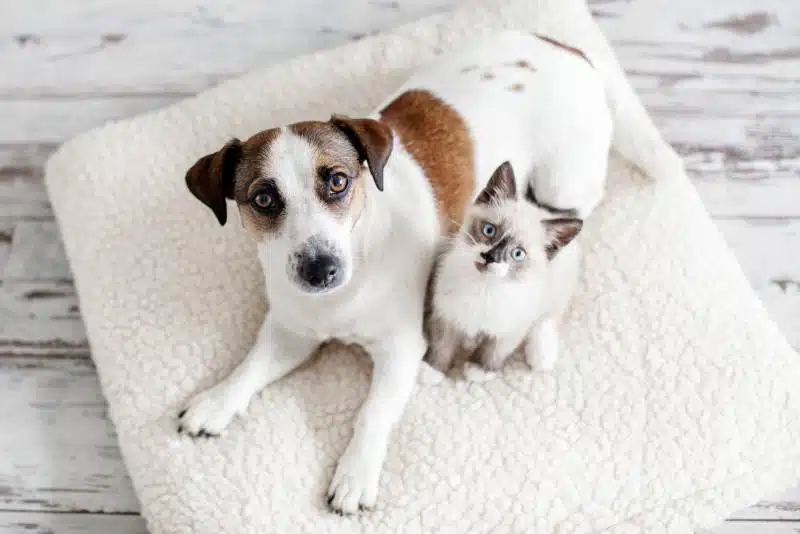
Understanding Dog and Cat Behavior
Creating a harmonious environment for your dog and cat starts with understanding their natural instincts. While we adore our pets for their unique personalities, it’s their deeply ingrained behaviors that often set the stage for how they interact. Every dog and cat relationship begins with understanding. With a bit of patience and insight, you can transform even the most skeptical pets into peaceful companions.
Dogs: The Enthusiastic Companion
Dogs are inherently social creatures. Their pack mentality makes them eager to engage with others—sometimes too eager. A wagging tail and playful bark may seem inviting to us, but to a cat, this behavior can appear overwhelming or even threatening. Dogs also possess a prey drive, which varies by breed and individual. This instinct can lead to chasing behaviors, especially when a cat darts across the room. For example, high-energy breeds like Border Collies may struggle to resist the urge to chase a fast-moving feline.
Cats: The Independent Observer
Cats, on the other hand, are territorial and prefer to approach new situations on their own terms. They value their space and often retreat to high perches or secluded spots when they feel threatened. A hissing or swiping cat isn’t being mean; they’re setting boundaries. Providing cats with vertical spaces, like cat trees or shelves, can significantly reduce their stress levels. According to a study by the American Veterinary Medical Association, vertical spaces help cats feel secure and in control of their environment, reducing stress in multi-pet households by up to 40%.
Why Conflicts Arise
When these instincts collide, misunderstandings happen. A dog’s enthusiasm can be misinterpreted as aggression, and a cat’s defensiveness might escalate the situation. Common conflicts include:
- Chasing: Dogs may instinctively pursue a running cat.
- Hissing or Growling: Cats use these vocalizations to warn off perceived threats.
- Hiding: Cats may retreat to avoid interaction, creating stress if no safe spaces are available.
“Pay attention to subtle stress signals, such as a dog’s stiff body posture or a cat’s flattened ears. Recognizing these early signs can help you intervene before tensions escalate,” says Dr. Esther Knoetze, BSc, BVSC.
“I once worked with a family whose energetic Labrador, Max, struggled to resist chasing their shy Siamese cat, Bella. By providing Bella with high perches and using structured introductions, we successfully built a peaceful dynamic.”
Related Reading:
- Understanding Feline Anxiety: The Science Behind Stress
- The Complete Guide to Fostering Positive Dog Behavior: Science-Based Methods
- Essential Dog Training Commands and Practical Tips for Pet Parents
By acknowledging these natural behaviors, you can better prepare for the journey ahead. The next step? Setting up your home to cater to both species’ needs and minimizing potential conflicts from the start.
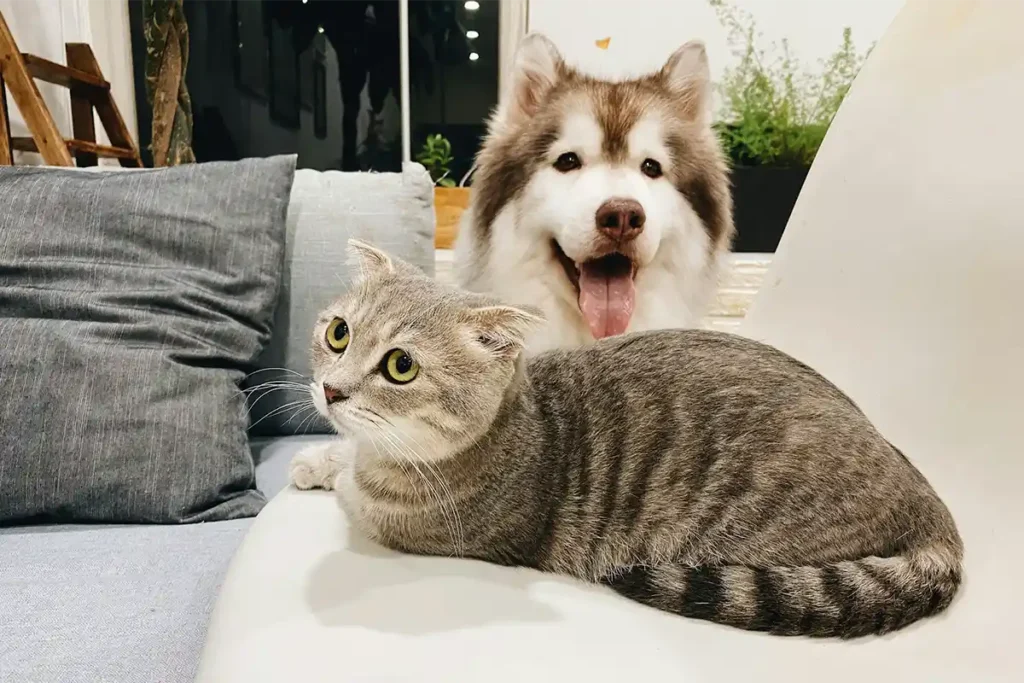
Preparing Your Home for Coexistence
Once you understand the natural instincts of your dog and cat, the next step is preparing your home to support a peaceful introduction. The environment you create plays a pivotal role in reducing stress and preventing misunderstandings. It’s normal to feel a little nervous about this process, but these steps will set you up for success.
Create Safe Spaces
Cats and dogs perceive and use space differently. While dogs are typically content to roam shared areas, cats need private retreats where they can feel secure. Setting up designated safe zones for both pets ensures they have spaces to retreat if overwhelmed.
- Vertical Spaces for Cats: Install cat trees, shelves, or window perches to give cats elevated areas where they feel in control and out of reach of curious dogs. According to the American Veterinary Medical Association, vertical spaces reduce stress in cats by up to 40% in multi-pet households.
- Quiet Zones for Dogs: Designate a corner with a comfy bed or crate where your dog can relax undisturbed. Dogs benefit from having a predictable, safe area to retreat to, especially during stressful moments.
Scent Swapping: An Essential Step
Think of scent swapping as your pets exchanging friendly “letters” before they meet face-to-face. This gradual introduction helps both animals recognize and accept one another without the stress of direct contact.
How to Swap Scents:
- Place a blanket or toy your cat frequently uses in your dog’s area and vice versa.
- Allow each pet to sniff the items at their own pace.
- Refresh the scent items daily for several days to reinforce familiarity.
Pet-Proofing Your Home
Anticipate potential problems by pet-proofing your living space:
- Secure Cords and Fragile Items: Prevent accidents by keeping wires, breakables, and small objects out of reach.
- Block Off Unsafe Areas: Use baby gates or barriers to restrict access to certain rooms.
- Protect Favorite Spots: Cover furniture or other surfaces with washable covers during the adjustment period.
“Using pheromone diffusers like Feliway for cats and Adaptil for dogs can create a calming environment during this transition period,” advises Dr. Esther Knoetze, BSc, BVSC. “I once worked with a family whose shy rescue cat, Luna, and excitable Beagle, Charlie, successfully coexisted by using these tools alongside scent swapping and vertical spaces.”
Checklist for Readiness
Related Reading:
- Complete Guide to Cat Proofing Your Home: Vet-Approved Safety Solutions
- 9 Simple Ways to Make Your Dogs Happy: Vet-Approved Tips
- Why Regular Checkups Are Important to Your Pet’s Health
By taking these preparatory steps, you’re laying the foundation for a peaceful coexistence. The next step is carefully planning the first interactions between your dog and cat, ensuring a positive start to their relationship.
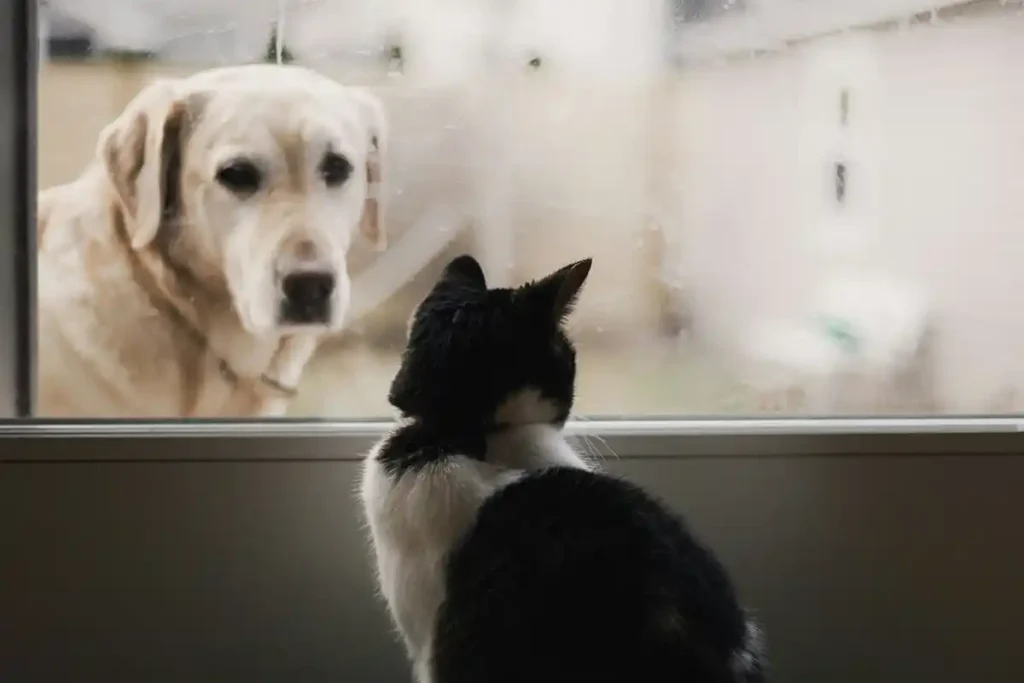
Step-by-Step Introduction Guide
Now that your home is prepared, it’s time to introduce your dog and cat. First impressions matter, and a structured approach ensures that their first interactions are calm, positive, and stress-free. Here’s a step-by-step guide to make the process as smooth as possible. Think of these first meetings as a diplomatic summit for your pets, complete with treats as peace offerings.
Step 1: Pre-Introduction Preparation
Before your pets meet face-to-face, set the groundwork for a successful introduction.
- Assess Temperaments: Is your dog overly excitable or your cat highly skittish? Adjust the process to match their personalities. For instance, a high-energy dog may benefit from a long walk beforehand to burn off extra energy.
- Use Physical Barriers: Baby gates, crates, or pet playpens can allow your pets to see and smell each other without direct contact.
- Keep Sessions Short: Initial pre-introduction sessions should be no longer than 5-10 minutes. Remember, quality over quantity is key.
Step 2: Controlled Visual Introductions
Let your dog and cat see each other in a controlled and safe environment.
- Start at a Distance: Position your dog and cat so they can see each other but cannot physically interact. Reward calm behavior with treats and praise.
- Watch Body Language: A wagging tail or curious gaze from your dog is positive, but signs of stiffness or growling signal the need for a break.
- Repeat Sessions: Gradually reduce the distance over several days as both pets grow more comfortable.
Step 3: Supervised Face-to-Face Meetings
Once your pets appear calm and curious about each other, it’s time for their first close interaction.
- Leash Your Dog: Keep your dog on a leash to ensure control and safety.
- Allow the Cat to Approach: Let the cat initiate contact while maintaining a clear escape route.
- Use Positive Reinforcement: Reward both pets with treats and praise for calm behavior.
Step 4: Gradually Increase Interaction Time
Over time, extend the duration of their interactions while monitoring closely.
- Encourage Joint Activities: Use toys to engage both pets in a shared activity, such as chasing a feather wand (for the cat) or gently playing tug with your dog.
- Keep It Low-Key: Avoid overly stimulating environments or loud noises during these early interactions.
- Monitor Stress Signals: If either pet shows signs of stress, such as hissing, growling, or trying to hide, pause the session and try again later.
“Short, frequent meetings are more effective than long, stressful interactions,” advises Dr. Esther Knoetze, BSc, BVSC. “I once worked with a family whose hyper Labrador, Max, and shy Persian cat, Bella, learned to coexist peacefully over three weeks of gradual introductions. Patience is crucial. For some pets, building trust may take weeks or even months.”
Common Mistakes to Avoid
⚠️Rushing the Process
Hurrying the introduction can backfire and create lasting tension. Take time to build trust gradually.⚠️Ignoring Body Language
Subtle signs, like a dog stiffening or a cat’s dilated pupils, indicate stress and should not be overlooked.⚠️Forcing Interactions
Allow both pets to set the pace and don’t force proximity if either seems uncomfortable.Related Reading:
- How to Help Your Dog and Cat Coexist: The Ultimate Guide for Pet Harmony
- Understanding Separation Anxiety in Dogs
By following this step-by-step approach, you’re setting the stage for a positive and lasting relationship between your dog and cat. Studies show that pets introduced over a period of weeks are 50% more likely to coexist peacefully compared to rushed introductions. Next, we’ll explore long-term strategies for maintaining harmony in your multi-pet household.
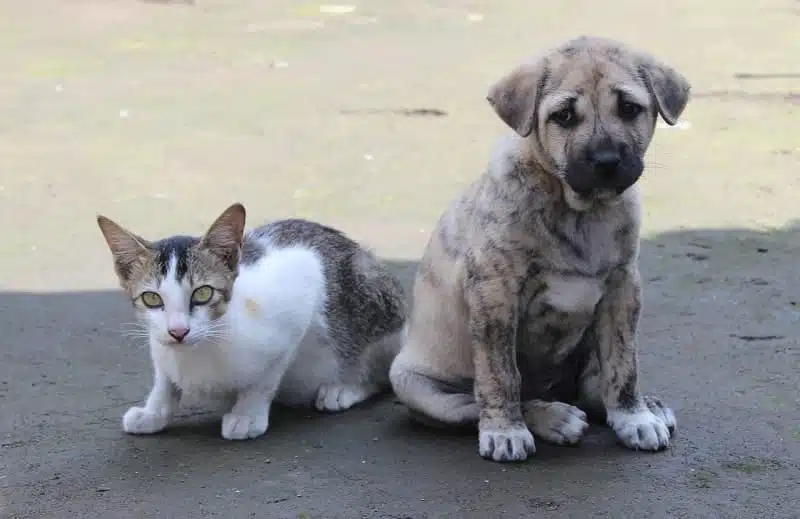
Long-Term Harmony Tips
Successfully introducing your dog and cat is just the first step. Maintaining peace and harmony in a multi-pet household requires ongoing effort and observation. These strategies will help you foster a lasting bond between your pets while ensuring their individual needs are met.
Monitor Interactions
Even after the initial introductions are complete, keep an eye on how your pets interact daily. Sharing your home with both a dog and a cat can feel like walking a tightrope some days, but small, consistent efforts lead to big changes.
- Recognize Stress Signals: Look for subtle cues such as a dog staring intensely at the cat or a cat swishing its tail. These can indicate discomfort or tension.
- Separate When Necessary: If tensions arise, give both pets some space by placing them in separate rooms or their designated safe zones.
- Adjust as Needed: Some days may be more challenging than others, especially if one pet is feeling unwell or stressed.
Encourage Joint Activities
Shared activities can help build positive associations between your dog and cat.
- Play Together: Use toys that both pets can enjoy, such as a laser pointer for the cat and interactive puzzle feeders for the dog. Picture your dog and cat napping together—yes, it’s possible with these tips!
- Shared Relaxation: Encourage calm moments together, such as lounging in the same room while you read or watch TV.
- Supervised Outdoor Time: If possible, let your dog and cat explore a secure backyard together under your supervision.
Establish Consistent Routines
Both dogs and cats thrive on predictability, and a consistent daily schedule can reduce stress.
- Mealtime Routines: Feed both pets at the same time but in separate areas to avoid resource guarding.
- Play and Exercise: Schedule regular playtime for each pet to burn off energy and prevent frustration.
- Training Sessions: Reinforce basic commands for your dog, such as “leave it” or “stay,” to maintain boundaries.
“Regular health check-ups are essential in multi-pet households,” advises Dr. Esther Knoetze, BSc, BVSC. “Subtle health issues, like dental pain or joint discomfort, can cause irritability and affect how pets interact. By addressing these issues early, you can prevent unnecessary conflicts.” Dr. Knoetze recalls a family whose Labrador and rescue tabby initially clashed over space. With consistent routines and shared playtime, the two pets developed a peaceful bond.
Handling Seasonal Stressors
Events like fireworks, holiday gatherings, or even changes in weather can disrupt harmony.
- Provide a Retreat: Ensure both pets have access to their safe spaces during noisy events.
- Use Calming Aids: Pheromone diffusers, calming collars, or anxiety wraps can help pets stay relaxed. Studies show that these aids can reduce stress-related behaviors by up to 30%.
- Minimize Disruption: Stick to your established routines as closely as possible during stressful times.
Related Reading:
- 12 Science-Backed Ways to Keep Your Dogs and Cats Cozy This Winter
- Is Your Dog Depressed? 4 Warning Signs and What to Do
By incorporating these strategies into your daily routine, you’ll help ensure a harmonious environment where your dog and cat can thrive together. Patience and consistency are key to nurturing a peaceful multi-pet household.
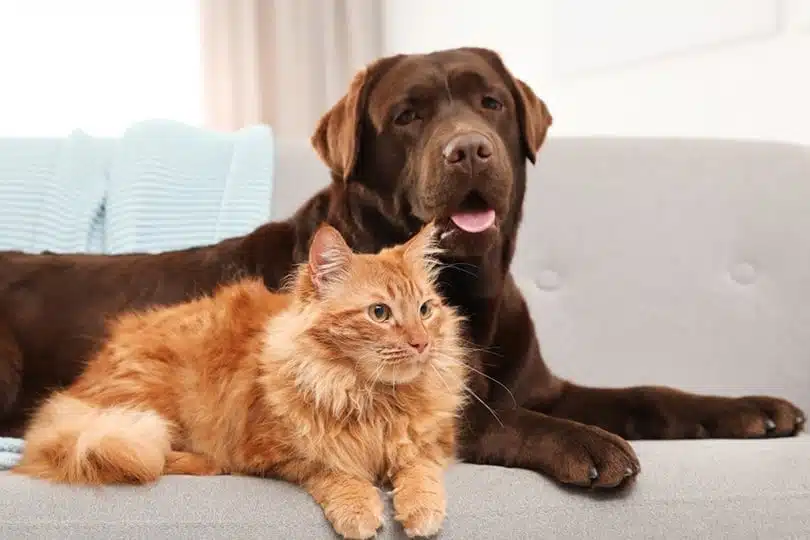
Troubleshooting Common Problems
Even with careful planning and consistent effort, conflicts between your dog and cat may arise. Addressing these issues promptly and effectively is key to maintaining harmony. Here are common problems and solutions to help you navigate these challenges. Remember, every step forward strengthens their bond.
Aggression Between Pets
Aggressive behavior can occur if one pet feels threatened or overstimulated.
- Recognize the Signs: Growling, hissing, barking, or lunging are clear indicators of discomfort. Subtler signs include flattened ears in cats or a dog’s rigid body posture.
- Separate Immediately: If aggression occurs, separate the pets and give them time to calm down in their respective safe spaces.
- Revisit the Introduction Process: Return to earlier steps, such as scent swapping and visual introductions, to rebuild trust.
Imagine a scenario: your dog charges at the cat after an exciting play session. Recognizing the trigger—overstimulation—and providing separation can help reset the situation.
Resource Guarding
Pets may become territorial over food, toys, or sleeping areas.
- Designate Separate Areas: Feed pets in different rooms and provide individual toys to prevent competition.
- Rotate Resources: Introduce new toys or switch up sleeping arrangements to reduce possessiveness.
- Use Positive Reinforcement: Reward calm and non-guarding behavior with treats and praise.
Dr. Knoetze recalls a case where a family’s Beagle, Daisy, would guard her bed from their Persian cat, Leo. By creating distinct sleeping zones and rewarding calm behavior, the family saw a significant improvement in just a few weeks.
Jealousy or Attention-Seeking
Competition for your attention can lead to conflicts or undesirable behaviors.
- Equal Attention: Spend quality time with each pet individually to ensure they feel valued.
- Structured Playtime: Schedule group activities where both pets can participate, such as supervised play sessions with interactive toys.
- Ignore Negative Behaviors: Avoid reinforcing attention-seeking behaviors like excessive barking or meowing.
“If aggression or guarding behaviors persist despite your efforts, consult a professional,” advises Dr. Esther Knoetze, BSc, BVSC. “A veterinarian or animal behaviorist can help identify underlying issues and develop tailored strategies for your pets. Health problems, such as arthritis or dental pain, often exacerbate behavioral issues and should not be overlooked.”
When to Seek Professional Help
Related Reading:
- 11 Warning Signs You Should Take Your Dog to the Vet
- Understanding Separation Anxiety in Dogs
- The Complete Guide to Fostering Positive Dog Behavior: Science-Based Methods
- Understanding Feline Anxiety: The Science Behind Stress
By addressing these common challenges early, you’ll create a more peaceful and enjoyable environment for both your dog and cat. Conflicts between pets can be stressful, but proactive care, patience, and tailored strategies make all the difference in fostering a lasting bond.
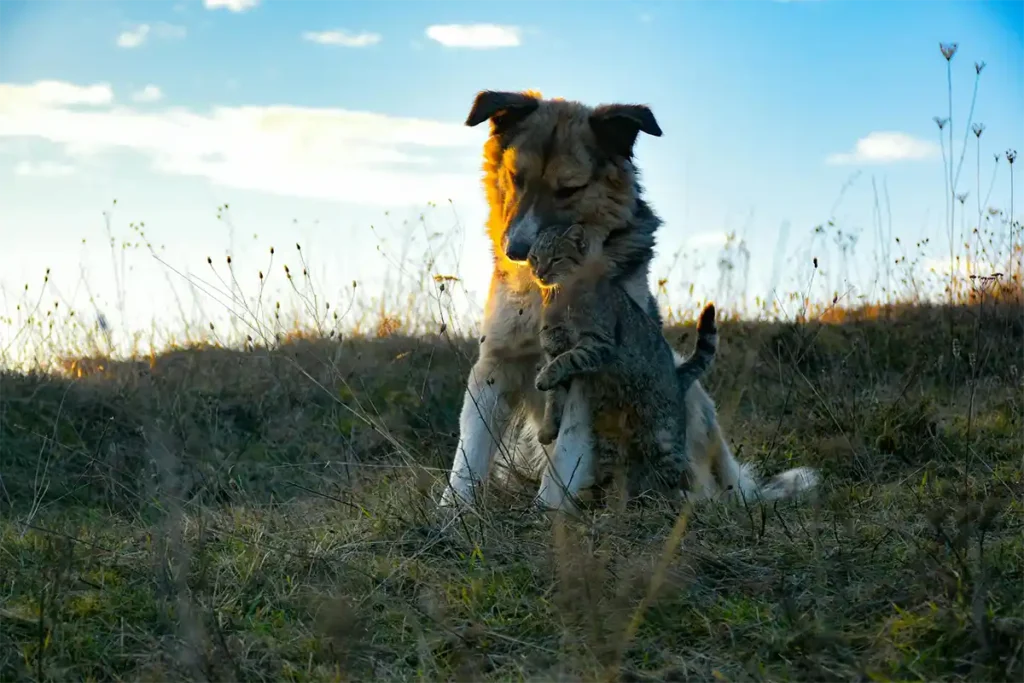
FAQ: Helping Dogs and Cats Coexist Peacefully
How long does it take for a dog and cat to get along?
+The timeline for dogs and cats to adjust varies depending on their individual temperaments, past experiences, and the introduction process. Some pets may begin to tolerate each other within a few days, while others may take weeks or even months to build trust. Remember, patience and consistency are key—every small step brings you closer to harmony.
🐾 Tailwaggors Tip:
Every pet is unique – don’t rush the process. Focus on positive reinforcement and celebrate small victories along the way.
What is the best way to introduce a dog to a cat?
+Start by preparing your home with safe spaces for both pets. Use scent swapping to familiarize them with each other’s presence before a face-to-face meeting. Gradually introduce them using barriers like baby gates, and always reward calm behavior with treats and praise.
🩺 Veterinary Insight:
“Using pheromone diffusers during introductions can help reduce stress levels for both pets,” advises Dr. Esther Knoetze.
Why does my dog chase my cat, and how can I stop it?
+Dogs often chase cats due to their prey drive or excitement. To stop this behavior:
- Teach your dog commands like “leave it” to redirect their focus
- Provide plenty of exercise to burn off excess energy
- Ensure your cat has vertical spaces to escape to if needed
Did you know? Studies show that consistent training reduces chasing behaviors by up to 50%.
Can a dog and cat ever become best friends?
+Yes, many dogs and cats form close bonds over time. Building trust through gradual introductions, shared activities, and positive reinforcement can lead to a strong friendship. Even if they don’t become best friends, they can learn to coexist peacefully.
🩺 Veterinary Insight:
Dr. Knoetze recalls a heartwarming case where a Labrador, Max, and a shy tabby, Luna, became inseparable companions after weeks of gradual playtime.
What are the signs of a successful dog-cat relationship?
+Signs of success include:
- Relaxed body language during interactions
- Peaceful coexistence in shared spaces
- Playing together or calmly ignoring each other
- Eating meals in the same room without conflict
🐾 Tailwaggors Tip:
When your dog and cat start lounging together, you know you’ve hit the jackpot of pet harmony!
What should I do if my dog growls at my cat?
+Growling is a warning sign that your dog feels uncomfortable or threatened. Here’s what to do:
- Separate the pets immediately and allow them to calm down in their safe zones
- Revisit earlier steps, such as scent swapping and visual introductions
- Reward calm interactions to rebuild trust
🩺 Veterinary Insight:
Early intervention is crucial. Don’t punish growling as it’s an important warning signal – instead, address the underlying cause.
How can I reduce jealousy between my dog and cat?
+Jealousy often stems from competition for attention. To reduce it:
- Spend quality time with each pet individually to ensure they feel valued
- Schedule structured playtime where both pets can participate
- Reward calm and cooperative behavior with treats and praise
🐾 Tailwaggors Tip:
Try to maintain consistent routines for feeding, play, and attention to help both pets feel secure.
When should I seek professional help for my pets?
+If you notice persistent aggression, stress-related behaviors (e.g., over-grooming or hiding), or an inability to coexist despite your efforts, consult a veterinarian or certified animal behaviorist. Health problems, such as arthritis or dental pain, often exacerbate behavioral issues and should not be overlooked.
🩺 Veterinary Insight:
“Don’t wait until a crisis occurs. Early intervention can prevent minor issues from becoming major problems,” advises Dr. Knoetze.
What tools can help create harmony between dogs and cats?
+Useful tools include:
- Pheromone diffusers (e.g., Feliway, Adaptil)
- Interactive toys for joint play
- Baby gates or barriers for controlled introductions
- Training aids like clickers or treats for positive reinforcement
🐾 Tailwaggors Tip:
Start with essential tools like baby gates and gradually add others based on your pets’ specific needs.
Can I leave my dog and cat alone together?
+Never leave a newly introduced dog and cat alone unsupervised. Once they consistently show calm behavior and mutual respect over an extended period, you can gradually increase the time they spend together without supervision, starting in a controlled environment.
🩺 Veterinary Insight:
“Even after pets seem comfortable together, ensure both have access to safe spaces and escape routes when you’re not home,” recommends Dr. Knoetze.
These FAQs address common concerns and provide actionable solutions to help your dog and cat coexist peacefully. Remember, every small victory—like a calm sniff or shared nap—brings you closer to lasting harmony. If you have more questions, feel free to reach out or leave a comment!
Conclusion
Bringing a dog and cat into harmony under one roof is no small feat, but it’s far from impossible. With thoughtful preparation, structured introductions, and ongoing care, you’re well on your way to creating a home where both pets feel safe, loved, and respected.
- • Create Safe Spaces: Designate separate areas for each pet, such as vertical spaces for cats and quiet zones for dogs. This gives both pets their own territory where they can feel secure and relaxed.
- • Use Scent Swapping: Introduce pets to each other’s scents before direct interactions to ease their transition. This helps create familiarity and reduces stress during face-to-face meetings.
- • Take It Slow: Follow a step-by-step introduction plan, using positive reinforcement and observing body language. Patience during this process helps build lasting trust between your pets.
- • Establish Consistent Routines: Maintain regular mealtimes, playtimes, and training sessions to reduce stress. Predictability helps both pets feel secure in their environment.
- • Monitor Interactions: Watch for signs of tension, such as growling or hissing, and address issues promptly. Early intervention prevents small issues from becoming major problems.
“Patience and consistency are your best tools in fostering a strong bond between your dog and cat,” says Dr. Esther Knoetze, BSc, BVSC. “Every pet is unique, and some may take longer to adjust than others. But with love and persistence, even the most unlikely pairs can learn to coexist peacefully.” Dr. Knoetze recalls a family whose Golden Retriever, Max, and Siamese cat, Luna, overcame initial wariness through gradual introductions and shared playtime, eventually becoming inseparable companions.
Celebrate the Milestones
When you spot your dog and cat enjoying a sunny nap together, you’ll know all your effort was worth it. Remember, progress often comes in small steps. Celebrate every milestone, whether it’s a calm interaction during playtime or a gentle sniff of acknowledgment.
Related Reading:
- First Aid for Pets: What Every Owner Should Know
- Why Regular Checkups Are Important to Your Pet’s Health
- Prevent Cat Poisonings: Essential Tips and Emergency Advice for Pet Owners
Share Your Story
We Want to Hear From You: What strategies have worked for your dog and cat? Share your experiences in the comments or connect with our community for more tips and support! Contact Tailwaggors
Meet the ultimate pet harmony guide—your roadmap to helping dogs and cats live peacefully together!
🐾✨ Discover expert tips, step-by-step introductions, and stress-free strategies to transform your home into a multi-pet haven.
Share this with your fellow pet parents and let them weigh in on their experiences! 🐶🐱❤️







